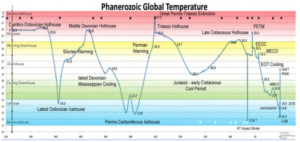by Andy May, August 8, 2017 in WUWT
The Bray cycle is about 2450 years from beginning to end and the Bray Lows, which are the coldest portion of the cycle, are the most important events.
The world is currently within the Quaternary Ice Age and nearly as cold as it has ever been. The normal average temperature of the world is around 20°C, some 5°C warmer than today. To keep recent warming in perspective, it is important to understand that even if the worse predictions of the IPCC were to occur, we would only be returning to the average temperature of the last 560 million years
Phanerozoic Global Temperature from Scotese 2015,
link in the post (.pdf)

by Geological Society of America, August 8, 2017 in ScienceDaily
Earlier studies had documented little change in the western Ross coastline prior to 1995, and the new study both confirmed the earlier work and extended the analysis to the present time.
This work underscores the complexity of Antarctic climate change and glacier response.
See also here
by Prof. Quansheng Ge, August 8, 2017 in ClimateChangeDispatch
Prof. Quansheng Ge and his group from the Institute of Geographic Sciences and Natural Resources Research, Chinese Academy of Sciences, collected a large number of proxies and reconstructed a 2000-year temperature series in China with a 10-year resolution, enabling them to quantitatively reveal the characteristics of temperature change in China over a common era.
See also here
by Elsevier SciTech Connect, August 2017
Since 1600, 278,880 people have been killed by volcanic activity, with many of these deaths attributed to secondary hazards associated with the main eruption. Starvation killed 92,000 following the 1815 Tambora eruption in Indonesia, for example, and a volcanic tsunami killed 36,000 following the 1883 Krakatoa eruption.
Research shows that volcanic activity has shown no let up since the turn of the 21st century – it just hasn’t been around population centres. Indeed, there remain a number of volcanoes poised to blow which pose a major threat to life and livelihood.
La géologie, une science plus que passionnante … et diverse

